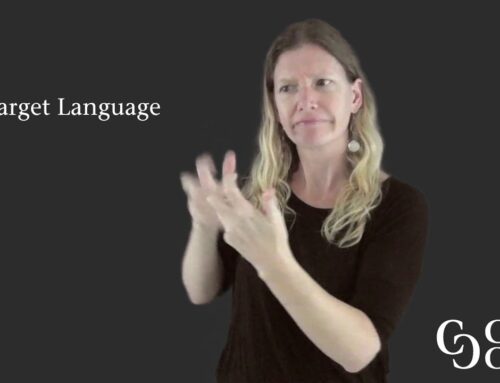Practice your use of constructed action and classifiers in this activity. Lurendran explains some tips for lifting heavy objects he learned while working construction.
You will start with a written summary of his text, create an ASL version of that, then view his original text and incorporate his descriptions into your own work.
Working on the parts at separate times allows for spacing out the learning that creates a desirable difficulty as described in the book Make It Stick.
Transferrable activity
The structure for this activity can be used with different skills – as well as with any ASL video that includes an English version (written or spoken.)
Key Skills
These are some of the key skills from Taylor (2002, 2017) that you can choose to focus on in this activity.
- Major Feature | Classifiers (Taylor, 2017)
- 4.3: Use accurate descriptive classifiers (p. 111)
- 4.4: Use accurate locative classifiers (p. 113)
- 4.5: Use accurate body classifiers and body part classifiers (p. 114)
- 4.6: Use accurate instrument classifiers and tool classifiers (p. 116)
- 4.11: Change from one classifier to another classifier or to a sign accurately (p. 122)
- Major Feature | Use of Space (Taylor, 2017)
- 5.3: Use accurate indexing techniques (p.137)
- 5.4: Use accurate spatial agreement (p. 141)
- 5.7: Use as much space as the interpretation requires (p. 149)
Time Required for Activity: 20 mins
Objective(s):
You will:
- Practice constructed action with an explanatory text
- Shadow native signer’s use of space and classifiers
References
Taylor, M. (2017). Interpretation Skills: English to American Sign Language. Edmonton: Interpreting Consolidated.
Taylor, M. (2002). Interpretation Skills: American Sign Language to English. Edmonton: Interpreting Consolidated.
Construction Tips for Lifting
Getting Started
Getting Started
To begin, click on the Step 1 toggle.
Select Language to Pair with ASL
To begin, you will need to decide whether you want to start with the English or Spanish written summary. Click the toggle below with the appropriate langauge.
Step 2: Create an ASL Version from English
Below is the English summary of the original ASL text. Here are the steps:
- Read through the English text
- Choose one of the following options to create an ASL version:
- Do a sight translation by signing a paragraph at the time.
- Record the text by reading it out loud so that you can interpret from the actual text. (Be sure to provide yourself with some pauses between sentences and paragraphs.)
- Record your ASL version to use for comparison for later steps.
Construction Site Tips for Lifting
So, I work in construction. As a construction worker my role is varied. I do everything from installing glass, to fixing motherboards on computers, to tables, to lighting among many other things that I’ve learned along the way.
Once, at work, I saw this Mexican guy who was lifting very heavy objects and transporting them by hand. I personally like lifting heavy things and I like the challenge because I am a gym buff. So I decided to help him out and when I lifted the items I realized they were very heavy. It was definitely a challenge to pick up and transport these things as each piece weighed 185 lbs. So I was picking up these pieces and bringing them over and over by holding them against my chest.
As I was doing this, the Mexican guy was laughing, and he came over to me and started speaking to me and said, “I could see that you’re a strong guy but you’re lifting by the wrong part of the frame. You need to pick them up using your forearm!”
I didn’t know what he was talking about and I imagined resting the pieces on my forearm while walking or putting it over my head while using my forearm or something. I had no idea what he was talking about. He explained that whenever you have a piece that’s rectangular and has a frame, it doesn’t matter what it is. It could be a window frame, a door frame, sheet metal, or a table. What you need to do is put your hand under the base of the and lift it up to where the wait of the entire object is resting on your forearm and balance it on the other end using your non-dominant arm. The item will feel really light. You could be carrying something that weighs 150 lbs and it will only feel like it weighs 45 or 50 lbs.
So after that I was able to carry a few more items with a lot less effort. I decided to try to carry two pieces, where each item weighed 110 lbs for a total of 220 lbs. So normally my max bench weight is 245 lb but I was able to lift both of these items with minimal effort. People were watching me go back and forth as I could easily do two or three pieces each trip. But I wouldn’t dare to do 4 because then my arm would go flying out of its socket!
So I was really glad to learn this technique and in the future if I see other people who are in construction or even in delivery on the street, I can go up to them and teach them this method. They are super thankful to me no matter who they are. Just trying to help people out and save their necks so they don’t have to worry as hard about dropping anything, tripping, or overworking themselves.
That’s something I’d recommend for anyone because in the future you might have to move, or install a window in your house, or even just move a table. Just remember the forearm method and lift it with your forearm, not forgetting to keep your arm at a 90 degree angle. With that you’ll be able to lift and transport things with ease!
Step 2: Create an ASL Version from Spanish
Below is the Spanish summary of the original ASL text. Here are the steps:
- Read through the Spanish text
- Choose one of the following options to create an ASL version:
- Do a sight translation by signing a paragraph at the time.
- Record the text by reading it out loud so that you can interpret from the actual text. (Be sure to provide yourself with some pauses between sentences and paragraphs.)
- Record your ASL version to use for comparison for later steps.
Consejos para cargar peso de una manera segura
Yo trabajo en la construcción, me dedico a instalar vidrios, arreglar las mothership de las computadora, las mesas y las luces. He aprendido hacer una variedad de tareas.
Una vez vi a un mexicano que cargaba cosas bien pesadas. En lo personal, me gustan los desafíos, me gusta cargar cosas muy pesadas, porque creo que es un buen ejercicio. Levantaba los objetos bien pesados con mis dos manos, cargaba cosas que pesaban como 185 libras, lo hacía apoyándolo contra mi pecho y solía hacerlo a menudo. Entonces, el mexicano riéndose me dijo: «Eres un muchacho muy fuerte pero estás cargando con la forma equivocada». Me quedé pensando y dije que estaba bien como lo hacía; sin embargo, me explicó que debería usar mi brazo, no entendí que me quería decir con eso, me imaginé que se referiría que cargara de una manera media rara, con el brazo alzado, pero me dijo que no era así.
Me explicó: digamos que cargas un objeto de vidrio de forma cuadrada, de metal, mesas o cualquier otro objeto cuadrado, debes meter la mano por debajo del objeto, te apoyas con el antebrazo para levantarlo, luego te apoyas con todo el brazo derecho. Así podrás cargar mesas, vidrios, metales o acero. Recuéstelo en el lado exterior del brazo, de esta manera lo sentirás liviano, aunque el objeto sea bien pesado, por ejemplo si cargas algo de 150 libras, se sentirá como de 45 a 50 libras.
No me había dado cuenta que la manera en cómo se cargan las cosas realmente hace la diferencia, ahora cargo hasta dos objeto, uno de 110 y otro de 120, con un total de 230 libras. Ahora, lo máximo que hago cuando levanto pesas es 245 libras. Gracias a la técnica que aprendí, cargo de 2 a 3 objetos y la gente me que mirando con los ojos bien abierto porque soy todo un experto. Ahora sé cómo hacerlo y no me voy a lastimar los músculos, he aprendido mucho por experiencia.
Ahora, cuando veo personas cargando cosas, sin importar, los paro e interrumpo para decirles: “Oye, te voy a enseñar una manera simple de cargar, con esta técnica de los brazos”. Ellos quedan agradecidos, se ve por la manera en como nos despedimos, chocándonos los puños, es que esta técnica les ayuda a todos a no gastar esfuerzos en vano. De no ser así, no van saber qué hacer si se caen o se tropiezan por no estar levantando peso de la manera correcta.
Esta técnica, una mano arriba y la otra abajo para apoyar al objeto, se hace más fácil, se puede caminar y transportar el objeto. Al explicarlo ahora vas a saber hacerlo, en cualquier situación que tengas que mudarte, cargar vidrios o mesas pesadas, recuerda usar el brazo como te dije y verás que sentirás que el peso es más liviano.
Si cargas con el brazo y antebrazo no importa qué tan grande es el objeto, vas a poder cargarlo con facilidad, luego lo llevas al piso y ¡listo!
Step 3: Initial Reflection
Spend some time reflecting on the following questions.
- In what areas did you feel the work was effective? What was happening for you at this point?
- What parts of the text were challenging for you to represent in ASL?
- Do you notice any patterns in your work?
Step 4: View & Shadow Original ASL Video
Now watch the original video from which the summaries were created. You will watch the video two times.
- First, watch the video and pay special attention to the spots where you struggled in Step 2.
- Second, watch the video a second time and shadow the signers, focusing on the specific skills you want to improve. For example, if you want to improve classifiers, don’t worry so much about non-manual markers.
Note: remember you can adjust the speed of the video by clicking the “gear” icon at the bottom of the YouTube video.
Step 5: Re-do Your ASL Version
Now that you have seen and shadowed the original video, re-do your ASL version – working either from the written text or from the audio recording of that text.
Both languages are included below.
Consejos para cargar peso de una manera segura
Yo trabajo en la construcción, me dedico a instalar vidrios, arreglar las mothership de las computadora, las mesas y las luces. He aprendido hacer una variedad de tareas.
Una vez vi a un mexicano que cargaba cosas bien pesadas. En lo personal, me gustan los desafíos, me gusta cargar cosas muy pesadas, porque creo que es un buen ejercicio. Levantaba los objetos bien pesados con mis dos manos, cargaba cosas que pesaban como 185 libras, lo hacía apoyándolo contra mi pecho y solía hacerlo a menudo. Entonces, el mexicano riéndose me dijo: «Eres un muchacho muy fuerte pero estás cargando con la forma equivocada». Me quedé pensando y dije que estaba bien como lo hacía; sin embargo, me explicó que debería usar mi brazo, no entendí que me quería decir con eso, me imaginé que se referiría que cargara de una manera media rara, con el brazo alzado, pero me dijo que no era así.
Me explicó: digamos que cargas un objeto de vidrio de forma cuadrada, de metal, mesas o cualquier otro objeto cuadrado, debes meter la mano por debajo del objeto, te apoyas con el antebrazo para levantarlo, luego te apoyas con todo el brazo derecho. Así podrás cargar mesas, vidrios, metales o acero. Recuéstelo en el lado exterior del brazo, de esta manera lo sentirás liviano, aunque el objeto sea bien pesado, por ejemplo si cargas algo de 150 libras, se sentirá como de 45 a 50 libras.
No me había dado cuenta que la manera en cómo se cargan las cosas realmente hace la diferencia, ahora cargo hasta dos objeto, uno de 110 y otro de 120, con un total de 230 libras. Ahora, lo máximo que hago cuando levanto pesas es 245 libras. Gracias a la técnica que aprendí, cargo de 2 a 3 objetos y la gente me que mirando con los ojos bien abierto porque soy todo un experto. Ahora sé cómo hacerlo y no me voy a lastimar los músculos, he aprendido mucho por experiencia.
Ahora, cuando veo personas cargando cosas, sin importar, los paro e interrumpo para decirles: “Oye, te voy a enseñar una manera simple de cargar, con esta técnica de los brazos”. Ellos quedan agradecidos, se ve por la manera en como nos despedimos, chocándonos los puños, es que esta técnica les ayuda a todos a no gastar esfuerzos en vano. De no ser así, no van saber qué hacer si se caen o se tropiezan por no estar levantando peso de la manera correcta.
Esta técnica, una mano arriba y la otra abajo para apoyar al objeto, se hace más fácil, se puede caminar y transportar el objeto. Al explicarlo ahora vas a saber hacerlo, en cualquier situación que tengas que mudarte, cargar vidrios o mesas pesadas, recuerda usar el brazo como te dije y verás que sentirás que el peso es más liviano.
Si cargas con el brazo y antebrazo no importa qué tan grande es el objeto, vas a poder cargarlo con facilidad, luego lo llevas al piso y ¡listo!
Construction Site Tips for Lifting
So, I work in construction. As a construction worker my role is varied. I do everything from installing glass, to fixing motherboards on computers, to tables, to lighting among many other things that I’ve learned along the way.
Once, at work, I saw this Mexican guy who was lifting very heavy objects and transporting them by hand. I personally like lifting heavy things and I like the challenge because I am a gym buff. So I decided to help him out and when I lifted the items I realized they were very heavy. It was definitely a challenge to pick up and transport these things as each piece weighed 185 lbs. So I was picking up these pieces and bringing them over and over by holding them against my chest.
As I was doing this, the Mexican guy was laughing, and he came over to me and started speaking to me and said, “I could see that you’re a strong guy but you’re lifting by the wrong part of the frame. You need to pick them up using your forearm!”
I didn’t know what he was talking about and I imagined resting the pieces on my forearm while walking or putting it over my head while using my forearm or something. I had no idea what he was talking about. He explained that whenever you have a piece that’s rectangular and has a frame, it doesn’t matter what it is. It could be a window frame, a door frame, sheet metal, or a table. What you need to do is put your hand under the base of the and lift it up to where the wait of the entire object is resting on your forearm and balance it on the other end using your non-dominant arm. The item will feel really light. You could be carrying something that weighs 150 lbs and it will only feel like it weighs 45 or 50 lbs.
So after that I was able to carry a few more items with a lot less effort. I decided to try to carry two pieces, where each item weighed 110 lbs for a total of 220 lbs. So normally my max bench weight is 245 lb but I was able to lift both of these items with minimal effort. People were watching me go back and forth as I could easily do two or three pieces each trip. But I wouldn’t dare to do 4 because then my arm would go flying out of its socket!
So I was really glad to learn this technique and in the future if I see other people who are in construction or even in delivery on the street, I can go up to them and teach them this method. They are super thankful to me no matter who they are. Just trying to help people out and save their necks so they don’t have to worry as hard about dropping anything, tripping, or overworking themselves.
That’s something I’d recommend for anyone because in the future you might have to move, or install a window in your house, or even just move a table. Just remember the forearm method and lift it with your forearm, not forgetting to keep your arm at a 90 degree angle. With that you’ll be able to lift and transport things with ease!
Step 6: Final Reflection
Now that you have gone through all the steps, reflect on what you have learned.
- What changed between your first and second attempts?
- Did the parts that were challenging the first time become easier the second time?
- Do you notice any patterns in your work?
- What areas do you feel like continue to need to be an area for focus?





